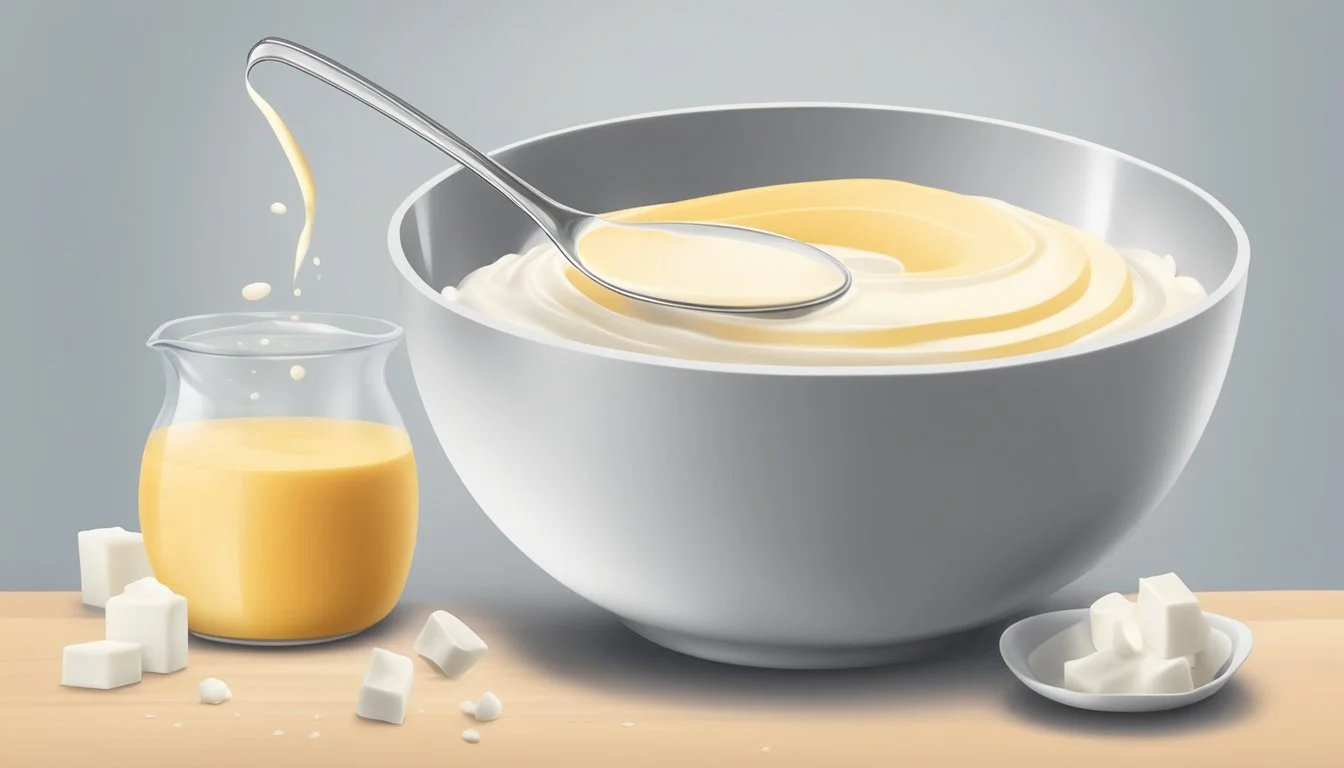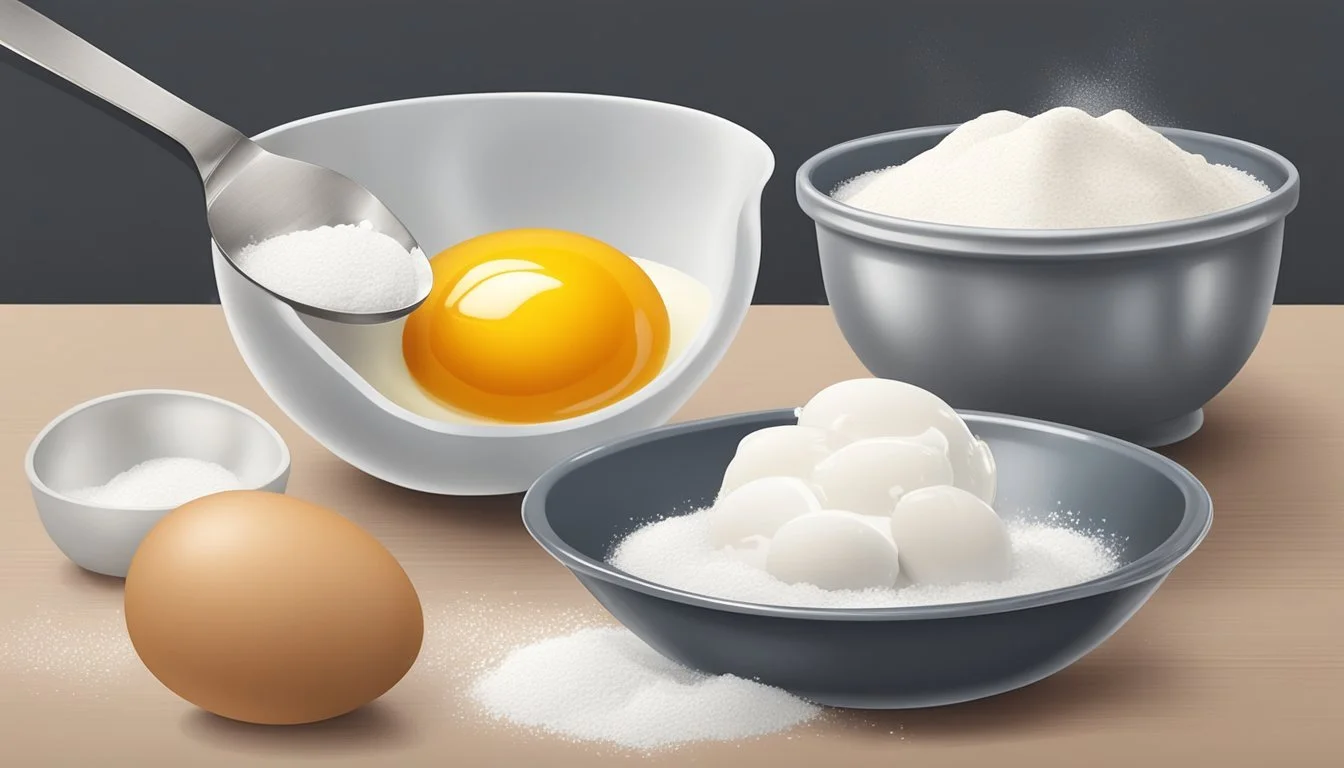How to Substitute Baking Powder
Effective Alternatives for Baking Success
Baking powder plays a crucial role in the kitchen, particularly in baking. As a leavening agent, it's responsible for the rise and fluffiness of cakes (how long do cakes last?), muffins, and other baked goods. Understanding the science behind baking powder can help bakers navigate situations where they might find themselves without it. Leavening agents work by producing gas that expands when heated, and baking powder, which contains both an acid and a base, reacts to moisture and heat by releasing carbon dioxide gas, resulting in the desired lift in baked concoctions.
There are situations when a baker might need to find a substitute for baking powder due to dietary restrictions, a preference for natural ingredients, or simply because they've run out. Fortunately, the effect of baking powder can be replicated with other common kitchen ingredients that can create similar chemical reactions. For example, combining baking soda, which is a base, with an acid like vinegar or yogurt can release the carbon dioxide needed to leaven baked goods. It's important to use the correct proportions to ensure the substitute provides the same leavening power as baking powder.
Understanding Baking Powder
Baking powder is a crucial leavening agent in a myriad of recipes, from cakes to pancakes, facilitating the creation of a light, fluffy texture by producing carbon dioxide gas during the baking process.
Composition of Baking Powder
Baking powder is composed of three primary ingredients: sodium bicarbonate, an acid, and a moisture-absorbing substance like cornstarch. The acid is typically either cream of tartar or sodium aluminum sulfate. This combination ensures that the baking powder remains inactive until it's moistened in a batter.
Ingredients of Baking Powder:
Sodium bicarbonate (Base)
Acid (Cream of tartar or sodium aluminum sulfate)
Cornstarch (Moisture absorber)
Mechanism of Leavening
The science behind baking powder's leavening action lies in the acid-base reaction. When baking powder is wetted in batter, the acid reacts with sodium bicarbonate to produce carbon dioxide gas. Heat accelerates this reaction, generating more gas and causing bubbles to form within the mixture. These bubbles expand as the temperature rises, adding volume to batters and doughs.
Leavening Process:
Wet mixture activates baking powder.
Acid reacts with sodium bicarbonate, producing carbon dioxide.
Bubbles form, making the batter rise.
Heat causes expansion, contributing to the fluffy texture.
Role in Recipes
In recipes, baking powder acts as a dependable leavening agent. It provides the desired rise without the need for additional acidic ingredients. Baking powder's presence is particularly vital in recipes that do not contain natural acids, ensuring that leavening still occurs and results in a consistent texture and volume across different baked goods.
Importance in Recipes:
Ensures rise in recipes lacking natural acids.
Provides uniform texture and volume.
Essential for creating light, fluffy baked goods like cakes and pancakes.
By understanding the composition and mechanism behind baking powder, as well as its critical role in recipes, bakers can better grasp the science of leavening agents and their influence on the texture and volume of baked goods.
Identifying Suitable Substitutes
In baking, substitutes for baking powder must be chosen carefully to ensure the desired rise and texture of the final product. This section will guide you through the process of selecting an appropriate alternative based on different situations and ingredients.
When to Use Substitutes
Substitutes for baking powder are often sought after when one is caught without this leavening agent at a crucial baking moment. They should serve the same chemical purpose as baking powder—releasing carbon dioxide to help dough rise—without significantly altering flavor or texture. It's crucial when a recipe calls for baking powder and the pantry comes up short.
Factors Affecting Substitute Choices
Choosing a substitute requires considering several factors:
Potency: Substitutes vary in their ability to leaven, which may affect how much is needed.
Acid: Baking powder is often replaced with an acid-base combination, hence the substitute must include an acidic component.
Liquids: Some substitutes involve additional liquids (e.g., buttermilk, yogurt), which may require adjusting other liquid quantities in the recipe.
Flavor: Strong-flavored substitutes should be used cautiously to prevent overpowering the baked goods.
Popular Baking Powder Substitutes
There are several well-known substitutes for baking powder, each with their own ratios and considerations:
Baking Soda and Cream of Tartar: Mix 1/4 teaspoon baking soda with 1/2 teaspoon cream of tartar for each teaspoon of baking powder.
Baking Soda and Vinegar: Combine 1/4 teaspoon baking soda with 1/2 teaspoon white vinegar to replace 1 teaspoon of baking powder.
Baking Soda and Lemon Juice: Use a mixture of 1/4 teaspoon of baking soda with 1/2 teaspoon of lemon juice as an equivalent to 1 teaspoon baking powder.
Buttermilk: When using buttermilk, mix 1/4 teaspoon baking soda with 1/2 cup of buttermilk, while reducing other recipe liquids by 1/2 cup.
Ingredient Baking Soda Acidic Component Notes Cream of Tartar 1/4 tsp 1/2 tsp Best for small quantities Vinegar 1/4 tsp 1/2 tsp Use white vinegar to avoid flavor changes Lemon Juice 1/4 tsp 1/2 tsp Adds a slight lemony flavor Buttermilk 1/4 tsp 1/2 cup Reduce other liquids by 1/2 cup
These ingredients are typically readily available in a home pantry and can act as immediate, effective substitutes for baking powder in baking recipes.
Recipes and Adjustments
When making substitutions for baking powder in recipes, it's important to maintain the balance of acid and base to ensure proper rise and texture. Precise measurements are key to achieving desired results in baked goods such as cakes, pancakes, and biscuits.
Adjusting Recipes for Substitutes
When a baker encounters a lack of baking powder, it's crucial to adjust recipes correctly. For each teaspoon of baking powder, one can combine 1/4 teaspoon of baking soda with 1/2 teaspoon of acid, such as vinegar or lemon juice. In batter-based recipes, the liquid component can accommodate this acidic addition without significant alteration to taste. To neutralize the baking soda and maintain the necessary rise in cakes or cookies, one must also consider the recipe's existing acidic components, such as buttermilk or yogurt, before adding more acid.
Alternative Substitutes for Common Baked Goods
For common baked goods, substitutions should be made with consideration for the final product's flavor and texture:
Cakes and Soufflés: A mixture of baking soda and a mild-tasting acid like cream of tartar or buttermilk is preferred to maintain the delicate structure and taste.
Pancakes and Waffles: Yogurt or buttermilk can be used with baking soda; these liquids contribute to the leavening while also adding tenderness.
Biscuits and Cookies: For recipes requiring crispiness, like cookies or flaky layers, as in biscuits, using baking soda with an acid like vinegar or lemon juice can be effective.
Homemade Baking Powder Recipes
To make one's own baking powder, a baker needs a 1:2:1 ratio of baking soda to cream of tartar to cornstarch. This blend ensures the acid-base reaction needed for leavening, while cornstarch prevents the mixture from clumping:
Ingredients Quantity Baking Soda 1 tablespoon Cream of Tartar 2 tablespoons Cornstarch 1 tablespoon
This homemade mixture should be stored in an airtight container to keep moisture out. One can replace each teaspoon of commercial baking powder needed with an equal amount of this blend. This substitution is especially useful for individuals with dietary restrictions or those seeking a sodium-free alternative in their baking recipes.
Dairy-Based Alternatives
When seeking substitutes for baking powder in recipes, dairy products like buttermilk and yogurt are excellent options due to their acidity, which can activate baking soda to help baked goods rise.
Using Buttermilk
To use buttermilk as a substitute, one must replace the liquid called for in the recipe with buttermilk and add baking soda. The traditional formula is as follows:
For 1 teaspoon of baking powder:
Substitute with 1/4 teaspoon of baking soda
Add 1/2 cup of buttermilk
The acidity of the buttermilk reacts with the baking soda to produce carbon dioxide gas, which gives pancakes their characteristic fluffiness.
Integrating Yogurt
Plain yogurt can be used in a similar manner to buttermilk. The steps to make this substitution are simple:
For each teaspoon of baking powder needed:
Combine 1/4 teaspoon of baking soda with the dry ingredients
Mix in 1/2 cup of plain yogurt with the wet ingredients
The use of plain yogurt, especially one that is not flavored or sweetened, maintains the balance of flavors in the recipe while still providing the necessary acid to act with baking soda for leavening.
Other Liquid Substitutes
In recipes where baking powder is absent, certain liquids can be combined with baking soda to produce the necessary carbon dioxide gas for leavening. These substitutes offer a range of flavors and acidity levels to suit different types of baked goods.
Vinegar Variations
One can use vinegar as a substitute for baking powder when it's paired with baking soda. The chemical reaction between baking soda and the acid in vinegar produces carbon dioxide gas, which helps doughs and batters rise. Commonly used types include:
White vinegar: It's the most neutral in flavor, making it a versatile choice for various recipes.
Apple cider vinegar: Offers a milder taste with a slight fruity undertone.
For every teaspoon of baking powder required, combine 1/4 teaspoon of baking soda with 1/2 teaspoon of vinegar.
Lemon Juice and Other Citrus
Lemon juice provides acidity just like vinegar, stimulating the production of carbon dioxide gas when mixed with baking soda. One may also consider other citrus juices for a hint of their distinct flavors. The ratio is similar to that of vinegar:
Lemon juice or other citrus juices should be mixed with baking soda at a ratio of 1/4 teaspoon of baking soda to 1/2 teaspoon of juice for every teaspoon of baking powder replaced.
Club Soda for Leavening
Club soda contains carbon dioxide gas which can give rise to baked goods in the absence of baking powder. It's particularly convenient for recipes that already call for a liquid component. Replace the liquid in the recipe with club soda, maintaining the original amount. Use in conjunction with baking soda if the recipe requires additional leavening.
Egg-Based Methods
In the realm of baking powder substitutes, egg-based methods stand out for their ability to impart a fluffy texture to baked goods. Whipped egg whites, specifically, can be a crucial aerating agent for recipes that call for a leavening effect.
Whipped Egg Whites
When a recipe requires both leavening and structure, whipped egg whites are an excellent baking powder substitute. The process involves beating the egg whites until they reach soft to stiff peaks, which can be folded into the batter. This incorporation of air mimics the effect of baking powder by creating a light and airy texture.
To substitute baking powder with whipped egg whites:
Ensure the egg whites are at room temperature for maximum volume.
Use an electric mixer to beat them until the desired peak stage is reached.
Gently fold the whipped egg whites into the batter to maintain their structure.
The ratio for substitution commonly used is:
About 2 egg whites for each teaspoon of baking powder omitted.
It's important to note that this method may not work for all recipes, especially those that require additional leavening beyond what the egg whites can provide. However, for pancakes, soufflés, and meringues, whipped egg whites offer a lift that closely resembles the effects of baking powder.
A Look at Self-Rising Flour
Self-rising flour emerges as a convenient staple for those seeking to create fluffy textures in various recipes. It provides a means to bypass the addition of baking powder and salt when assembling ingredients.
How Self-Rising Flour Works
To understand how self-rising flour functions, one must recognize its components. Self-rising flour is a blend that combines all-purpose flour, a leavening agent (typically baking powder), and salt. The ratio is precise:
1 cup self-rising flour contains:
1 cup all-purpose flour
1 ½ teaspoon baking powder
¼ teaspoon salt
When moisture and heat are introduced, the baking powder in self-rising flour activates, releasing carbon dioxide. The gas bubbles expand under the heat of baking, which, in turn, causes the dough or batter to rise, yielding a fluffy and light texture—ideal for cakes, muffins, biscuits, and other baked goods.
Substituting self-rising flour in recipes calling for all-purpose flour and baking powder can streamline the baking process. The user eliminates the separate measuring and mixing of baking powder and salt, reducing potential errors and ensuring consistent results across batches.
In summary, self-rising flour acts as an all-in-one solution that includes a leavening agent directly within the flour mix, providing an efficient alternative to separate baking powder additions and fulfilling its role as a valuable baking powder substitute.
Molasses and Other Sugars
In baking, molasses—not only a sweetener but also a by-product of sugar refining—offers unique properties when used as a substitute for baking powder. Understanding how to leverage molasses and combine it with other ingredients can be crucial for successful baking.
Sweet Alternatives
When substituting baking powder in recipes, one can use a combination of molasses and baking soda to achieve the desired leavening effect. Molasses contains an acid that can activate baking soda, releasing carbon dioxide and helping the dough rise. For every teaspoon of baking powder needed, substitute with a mixture of:
1/4 cup molasses
1/4 teaspoon baking soda
Key Points to Remember:
Ensure to reduce other liquids in the recipe to compensate for the additional liquid from molasses.
This substitution is best suited for baked goods where a molasses flavor is appropriate.
Aside from its use as a leavening agent, molasses brings a rich, caramel-like sweetness and dark color to baked goods. It's typically more robust in flavor compared to other sugars, which is why it's often used in recipes for gingerbread or spice cookies.
Regular sugar cannot replace baking powder directly because it lacks acidity. Thus, sugar itself is not a leavening agent. However, sugar plays an essential role in the texture and structure of baked items, and so it must be balanced with other ingredients to achieve the right outcome.
Considering Food Science
When substituting baking powder, one must understand the underlying food science, particularly the chemical reactions involved, dough expansion, and the role of sodium as it relates to leavening agents.
Chemical Reactions in Baking
In baking, leavening agents like baking powder are crucial for generating the necessary chemical reactions. Baking powder is a combination of sodium bicarbonate (baking soda) and an acid, commonly cream of tartar. When moisture is added, these ingredients react to form carbon dioxide gas. This gas is what gives baked goods their volume and soft texture.
Understanding Dough Expansion
The dough expands due to the gases released during the chemical reactions between leavening agents and moisture. The elasticity of the dough comes from gluten strands, which trap the gases, causing the dough to rise. This expansion is a delicate balance, relying on the correct proportion of ingredients and temperature control during baking.
The Role of Sodium
Sodium, found in sodium bicarbonate, plays a pivotal role in the development of the dough. It not only participates in chemical reactions as a base, but some sodium-based leavening agents might provide a salty taste if used excessively. To avoid this, one could use fillers like cornstarch in homemade baking powder substitutes to temper the flavor and control sodium content.





